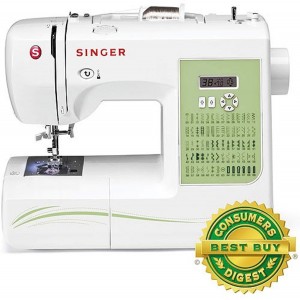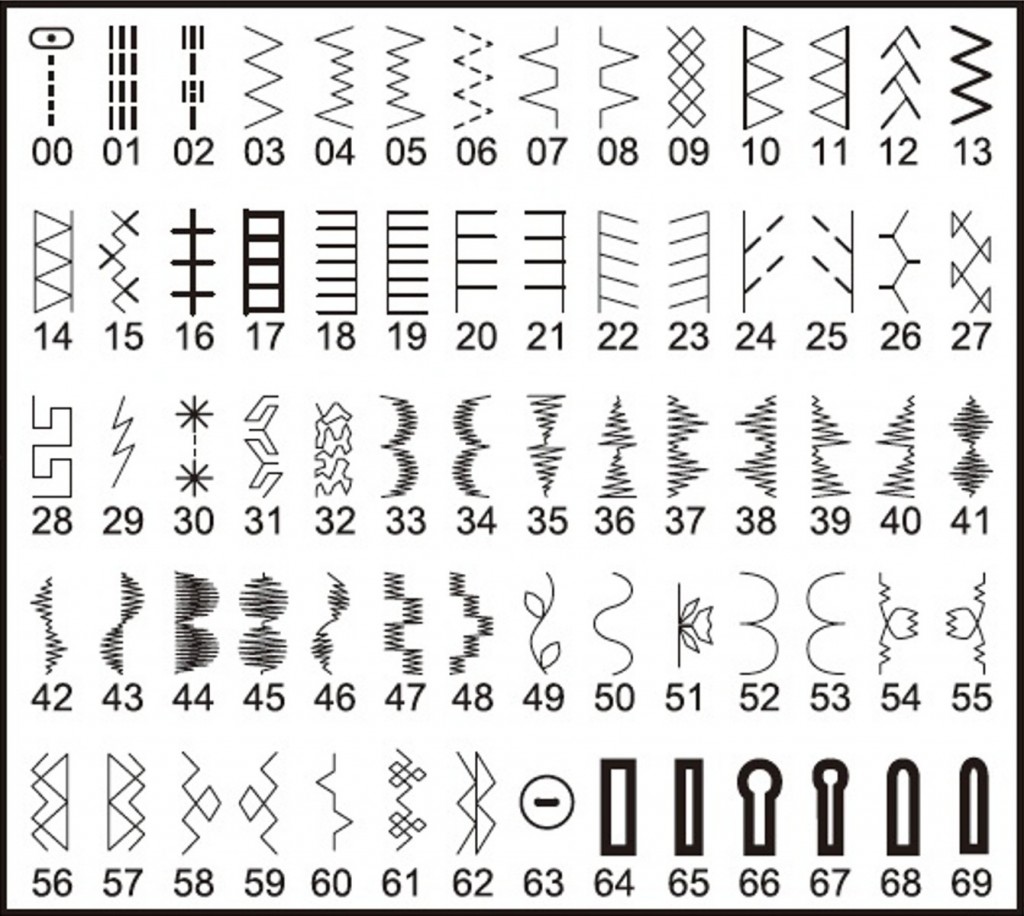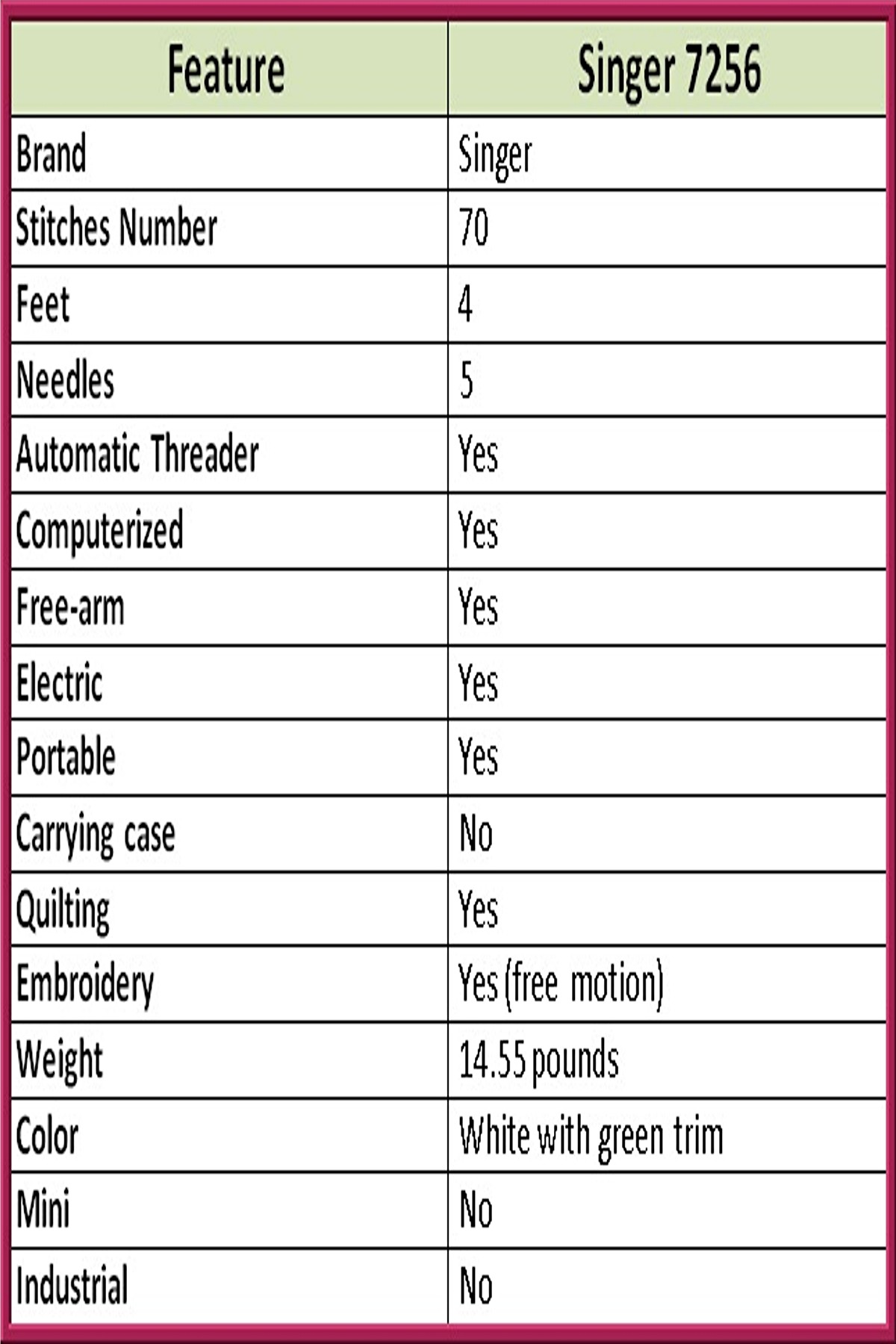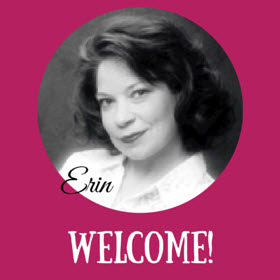 The Singer 7256 Fashion Mate sewing machine was awarded the Consumer Digest Best Buy Award for good reason.
The Singer 7256 Fashion Mate sewing machine was awarded the Consumer Digest Best Buy Award for good reason.
Beginners love the easy controls and feature set. The high marks from other users mean we might have finally found a Singer option that reminds us why this manufacturer was the standard for home machines for as long as it was.
Released in 2009, this model is an upgrade to the 7466 and if you look at the two side by side you’ll see that the design has been completely redone. It’s much more stylish with rounded corners and a fun, green splash across the bottom.
Table of Contents
(Click Ahead!)
Stitch Count / Presser Feet / Functionality / Accessories / Customer Reviews / Pros, Cons & Manual
REVIEW SUMMARY
MODEL: Singer 7256 Sewing Machine
REVIEWED BY: Erin
RATING: 4.5 
LAST UPDATED: April 9, 2015
COMPARE PRICES
Amazon
Not that looks matter when it comes to performance but for some of us (me included) if a machine is also more fun to look at, the odds are better that I’ll use it more rather than less.
My review shows you can get this sewing machine for well under $200, a deal for all you Singer fans!
Singer 7256 Sewing Stitches and 7mm Width
(Back to Top)
Included are 70 built in sewing stitches that run the gamut from utility to decorative, sating, heirloom and stretch stitches. In that mix, you’ll find 6 different styles of 1-step, automatic buttonholes.
This stitch selection is great for making clothes, hemming or altering you existing wardrobe, making home accessories, quilting, appliqué and free motion work.
Select stitches, like the zigzag stitch, can be modified in width up to 7mm and in length up to 6mm.
There’s even the neat stippling stitch for making a crazy design on your quilts. Have you ever seen quilts where a scrolling stitch has been run all through the pattern, maybe free form or in the shape of scrolls or hearts? The stippling stitch is a small version of that type of work done by the sewing machine itself instead of by free-hand, although you can do free motion stippling with this machine for wider, longer patterns in your quilting.
The stitch reference guide is printed right on the face of the Singer 7256 so no need to hunt around for your manual (which tends to wander farther and farther from your sewing machine over time).

Singer 7256 Included Presser Feet
(Back to Top)
Four snap-on type presser feet are included:
- General Purpose (Zigzag)
- Satin Stitch Foot
- Blind Stitch Foot
- Buttonhole Foot
Plenty of accessory feet are compatible for separate purchase including ruffler foot (Part # 270 086742) and an even feed walking foot (Part # 270 006185008).
Singer 7256 Sewing Machine Features
(Back to Top)
The computerized controls on the Fashion Mate consist of four buttons surrounding the LCD screen. This layout is popular on a lot of models produced the past several years. It’s intuitive, easy to learn, and helps change stitch selections and settings quickly.
Besides simple operation for beginners, there are lots of little extras built in to make threading , set up, and routine tasks as painless as possible:
- Automatic needle threader
- Automatic lock stitch
- Auto tie off feature
- Auto declutch bobbin winder
- Drop in bobbin
- Horizontal threading
- See through bobbin cover
- Six segment feed dog
- 750 stitches per minute
- Extra high presser foot height setting
- Twin needle capable
- Free arm sewing
- Automatic presser foot pressure
- Built in handle
- Built in work light
- 13 needle positions
- Two built-in, manual thread cutters (one on the left hand side of the machine and one on the right side of the presser foot shank)
The sewing machine has a metal interior frame and a housing of the high quality plastic used almost exclusively these days. It is sturdy but can be mounted to a cabinet to help support your larger fabric projects.
It sews nicely across a range of fabrics including chiffon and crepe, knits, jersey, a full variety of cotton fabrics, canvas, denim, duck, and sailcloth.
The feed dogs don’t drop but the Singer 7256 sewing machine comes with a darning plate which covers the feed dogs so you can do free motion work, attach buttons, or darn materials which require mending.
Two arrow keys under the LCD screen change the two digit stitch pattern selection and two side arrow keys change stitch settings like width and length. The needle plate has metric and inch markings.
The reverse button has two different jobs depending on which stitches are being sewn. With straight and zigzag, the reverse button will sew in reverse when pushed. For all other stitches, pushing the reverse button sews four tiny, tacking stitches in a compass pattern to lock the decorative stitches in place.
Having said all of these nice things, I’d have you do one thing if you like this sewing machine. Take a look at the Singer 7258. It has all of the same stitches as the 7256 plus 30 extra. It comes with 4 more presser feet. It also includes a collection of control buttons that let you have more control over the needle, starting and stopping the machine and speed: Start/Stop button, Needle Up/Down button, and the speed control slider that caps the maximum sewing speed. It’s also an excellent choice for beginners.
Dimensions: L 14.75” x D 7.25” x H 11.75”
Weight: 14.55 pounds
Singer 7256 Sewing Machine Accessories
(Back to Top)
These accessories come with the machine:
- Needles – 5
- Bobbins – 4
- Auxiliary spool pin
- Felt discs – 2
- Spool caps – 3 (mini, small, and large)
- Combination buttonhole opener, seam ripper, and lint brush
- Screwdriver
- Darning plate
- Dust cover
- Tips and project DVD from the Martha Stewart show
The smaller items can be stored inside the extension arm.
Singer 7256 Sewing Machine Reviews and Ratings
There are over 50 reviews on Amazon. The reviews are overwhelmingly positive and in particular mention how easy the machine is to use.
It’s been used to backup more industrial machines, gone through quilting, and been rated by beginners and very experienced seamstresses. For Singer, it’s another win in their lineup which was much needed for longtime brand diehards. Nice features and stitches with a low price make it an attractive option.
Average Rating: 4.5
Pros, Cons & Manual
![]() Pros: Operates quietly. Nice set of stitches. Feels solid during sewing. Easy to use. Automatic bobbin winder, drop in bobbin and automatic needle threader. Strong feed dog system. Beginners find it easy to learn.
Pros: Operates quietly. Nice set of stitches. Feels solid during sewing. Easy to use. Automatic bobbin winder, drop in bobbin and automatic needle threader. Strong feed dog system. Beginners find it easy to learn.
![]() Cons: The LCD screen is not backlit so it can be difficult to see in some conditions. LED light could be brighter. Presser foot pressure is not manually adjustable.
Cons: The LCD screen is not backlit so it can be difficult to see in some conditions. LED light could be brighter. Presser foot pressure is not manually adjustable.
Manual available online here: Get the Manual
Manufacturer’s Warranty: As of this date,the warranty in the US is 25 year limited on the machine head, limited 5 year warranty on motors, light, assembly, wiring, switches, speed control and electronic components, and a limited 1 year warranty on adjustments, belts, rings, bulbs, and attachments. As is standard with most warranties, the warranty may be void if certain requirements are not followed.
For current low price information, follow these links:
COMPARE PRICES
Amazon
Features Summary Review:


Between this and the Brother CS6000I, which is better for a beginner? I’ve used the Brother CS6000I before and loved it but everyone who I ask who sews often is telling me to go with a Singer…
I doubt you’ll be able to respond in time but… This machine is the deal of the day on Amazon.com today and is going for $119. I’ve been highly considering the 7258 but now I’m looking at this $80 off deal and considering going for it. I’m brand new to sewing. In my teens (maybe a decade ago) my mother bought me some kind of sewing machine for a gift and we never could get it to work right… I honestly think it may have been a bottom of the line Singer because that’s the brand my parents knew and that we had discussed at the time or it could’ve been something else but that machine was extremely complicated and I found out my mother just threw it out. Needless to say, due to a bad experience when I had a genuine interest in sewing before Im hesitant in general…
I also am not sure how much I’ll actually use the machine or not. I’m disabled and have a lot of health conditions and am often just about bed bound so on one hand I’d love to pick up a new hobby whereas on the other I’m not sure how much energy I actually have to be working on much of anything though I’ve always been very artsy/ craftsy so I imagine I’d eventually go back to the sewing machine even if it did begin to just collect dust. On the other hand it could be exactly the thing I need and a new favorite hobby so maybe I’ll want the extra features of the 7258? But the price is great today only on this model (7256) so I probably couldn’t go wrong. I admit I haven’t had enough energy to read and learn as much as I want to make a purchase but again this price is looking good…
I basically want a machine that can do a number of different things so I have options and can explore and have fun. I’d love to eventually sew my own clothes or even be able to make major alterations on my ld clothing as being sick has caused me to lose major amounts of weight (80lbs) and being petite in general, if all else fails just being able to hem pants shorter would be great! But I’d also love to do more crafty things, maybe make a simple quilt, etc. Presumably either of these machines and the comparable models by other brands would be more than enough to meet my needs?
And lastly (my apologies, I tend to ramble) it’s extremely important that any machine I buy be both reliable and fairly easy to teach myself to use. Because I’m homebound and can not make it out much at all I am not able to take classes nor would I be able to have to repeatedly take things in to get repaired. I’m sure judging by ratings that any of the machines I’m considering are going to be much more reliable and easier to use than my failed attempt at learning to use a sewing machine in my teens but what about ease of use? Will I be able to figure the basics out or follow online guides to hem pants or make some simple projects with it?
Tzi – I knew I stayed up past my bedtime for a reason! 😉
There are just a few differences between these two machines. Of course, the 7258 has more stitches but the 7256 has all the basic utility stitches you’d need to do the projects you described. You might have fewer decorative stitches but still plenty to work with. The 7256 also doesn’t have the control buttons for starting and stopping the machine with the push of a button – you have to use the foot pedal. There’s no speed control, either, as there is on the 7258. There’s also no button to move the needle up or down. However, those things only make sewing a bit easier – they don’t impact the performance of the machine or the quality of the stitches.
Both machines have a 6 point feed dog and similar operations other than the ones mentioned above. You should have no problems learning to operate the machine. The manual is fairly detailed, there are lots of tutorials online these days, and the controls are clearly marked.
If those things work for you, I’d grab that low price and run!
Sincerely,
Erin